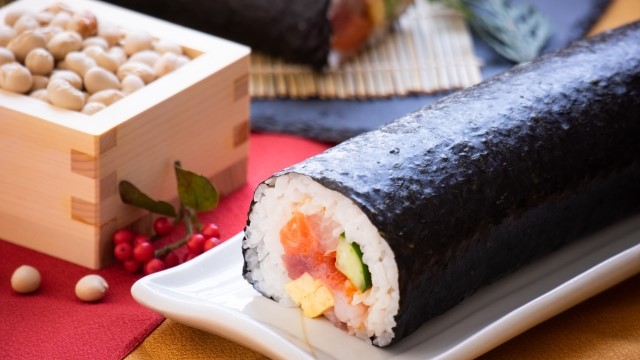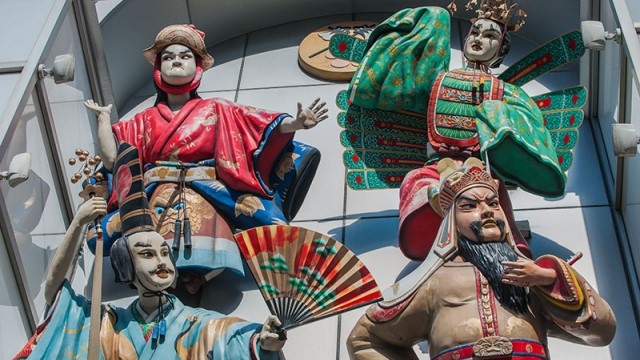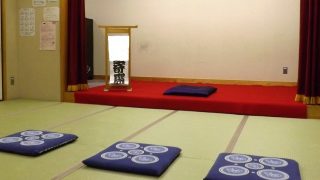About Setsubun (節分)
Setsubun is an event held at the turn of the season to ward off evil.
Initially, the day before the beginning of each season (Risshun-early spring, Rikka-early summer, Risshu-early fall, and Ritto-early winter) was called Setsubun, but it gradually came to mean only the day before the arrival of spring (Risshun- early spring) around February 3rd.
Setsubun also means to “divide the seasons.”
Traditionally, in Japan, it has been said that calamities tend to creep in at the turn of the seasons.
On the day of Setsubun, a sardine head is stabbed into a holly branch and displayed at the entrance of the house so that the devils will not like it and run away.
Every year on Setsubun, a ceremony is held at the shrine to throw dried soybeans while the person of the year (a man born in the year’s zodiac sign) chants “Fuku wa uchi, Oni wa soto.” At home, the father was to play the role of the person of the year (a man born in the year’s zodiac sign).
In recent years, the custom of “Eho-maki” has become very popular in Setsubun. It is said that if you face the direction of the year’s blessing (the direction of a good omen) and finish eating a whole Norimaki without cutting it and in silence, you will be blessed with good fortune
The beginning of beans throwing (Mame Maki)
In ancient China, there was a ceremony called ‘Tsuina’ on New Year’s Eve to drive away evil spirits. This is an event to drive away devils by shooting a bow and arrow made from peach trees.
It was introduced to Japan in the Nara period (710-794) and as a court event in the Heian period (794-1185). One of the events, “Mame-Uchi (beans beating),” became “Mame Maki (beans throwing),” which spread among the ordinary people in the Edo period.
It is said that the word was changed from “Uchi-beating” to “Maki-throwing” because it reflects the farmers’ desire for a good harvest and represents the way they sow the beans in the field.
Initially, it was held on New Year’s Eve, but according to the lunar calendar, since the new year starts in spring, it was held on Setsubun, the day before Risshun, and it has taken root as an event to drive away the evil spirits of Setsubun.
About the beans throwing
In Japan, devils are considered to be symbols of evil, and horrible events beyond human imagination, such as unseen disasters and famine, were considered to be the work of devils. Mame-maki (beans throwing) has become an established event to drive away evil spirits.
Bean

The beans used in the beans-throwing ceremony are soybeans, which are said to contain the grain spirit. People shout “Oni wa soto” and scatter beans as if they were hitting the devil outside to drive the devil away. They shout “Fuku wa uchi,” and the beans they throw in the house are picked up later and eaten as many years as one’s own. This is an old-fashioned custom.
Devil’s mask

A devil is a symbol of evil spirits, monsters, and other bad things. Bump the beans to drive them away. Nowadays, fathers often play the role of devils, but in the past, fathers played the role of the person of the year (a man born in the year’s zodiac sign).
The custom of Setsubun
Sardines and holly

On the night of Setsubun, there is a custom of sticking a roasted sardine head on a holly branch and decorating the house’s entrance. This was because it was thought that the devils would dislike the thorns of holly leaves and the stench of sardines and would retreat.
This is why the phrase “the sardine’s head is also from piety” (Iwashi no Atama mo Shinjin kara) was also born.
The head of a sardine is also from piety, which is a metaphor for the wonder of piety because even something as trivial as the head of a sardine looks very precious if you believe in it.
Eho-maki (Futo-maki)

Eho-maki is an auspicious Futo-maki roll that is said to bring good health and prosperous business by making a wish come true if you eat a whole Eho-maki without cutting it and in silence, facing the direction of good fortune (auspicious direction).
The direction of good fortune (Eho = 恵方) is based on the year’s zodiac sign, which is the best direction for the year and changes every year.
It is said to have been practiced in Osaka during the Edo period (1603-1867) and spread throughout the country in the late 1970s.
Many people still eat Eho-maki every year on Setsubun.
Let’s try!












